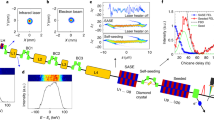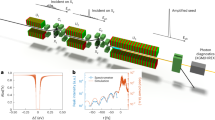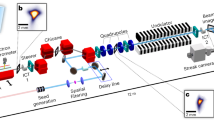Abstract
The Linac Coherent Light Source (LCLS) is an X-ray free-electron laser at the SLAC National Accelerator Laboratory, which has been operating since 2009 for a wide range of scientific research. The free-electron laser process at LCLS is based on self-amplified spontaneous emission (SASE) where spontaneous emission from the initial electron beam shot noise is amplified by its interaction with the electrons over a long magnetic undulator. Although SASE is very effective, producing tremendously powerful, ultrashort X-ray beams, the start-up from noise leaves poor temporal coherence and a broad, noisy spectrum. We present experimental results of a new method, suggested by colleagues at DESY, allowing self-seeding using X-rays from the first half of the undulator to seed the second half through a diamond-based monochromator, producing near Fourier-transform-limited X-ray pulses with 0.4–0.5 eV bandwidth at 8–9 keV. These results demonstrate self-seeding at ångstrom wavelengths with a relative bandwidth reduction of 40–50 with respect to SASE.
This is a preview of subscription content, access via your institution
Access options
Subscribe to this journal
Receive 12 print issues and online access
$209.00 per year
only $17.42 per issue
Buy this article
- Purchase on Springer Link
- Instant access to full article PDF
Prices may be subject to local taxes which are calculated during checkout






Similar content being viewed by others
References
Emma, P. et al. First lasing and operation of an angstrom-wavelength free-electron laser. Nature Photon. 4, 641–647 (2010).
Pile, D. First light from SACLA. Nature Photon. 5, 456–457 (2011).
Kondratenko, K. & Saldin, E. Generating of coherent radiation by a relativistic electron beam in an undulator. Part. Accel. 10, 207–216 (1980).
Bonifacio, R., Pellegrini, C. & Narducci, L. M. Collective instabilities and high-gain regime in a free electron laser. Opt. Commun. 50, 373–378 (1984).
Roseker et al. Performance of a picosecond X-ray delay line unit at 8.39 keV. Opt. Lett. 34, 1768–1779 (2009).
Chapman, H. et al. Femtosecond X-ray protein nanocrystallography. Nature 470, 73–77 (2011).
Yu, L. H. Generation of intense UV radiation by subharmonically seeded single-pass free-electron lasers. Phys. Rev. A 44, 5178–5193 (1991).
Stupakov, G. Using the beam-echo effect for generation of short-wavelength radiation. Phys. Rev. Lett. 102, 074801 (2009).
Togashi, T. et al. Extreme ultraviolet free electron laser seeded with high-order harmonic of Ti:sapphire laser. Opt. Express 19, 317–324 (2011).
Allaria, E. et al. The FERMI@Elettra free-electron-laser source for coherent X-ray physics: photon properties, beam transport system and applications. New J. Phys. 12, 075002 (2010).
Feldhaus, J. et al. Possible application of X-ray optical elements for reducing the spectral bandwidth of an X-ray SASE FEL. Opt. Commun. 140, 341–352 (1997).
Saldin, E. L., Schneidmiller, E. A., Shvyd'ko, Yu. V. & Yurkov, M. V. X-ray FEL with a meV bandwidth. Nucl. Instrum. Methods A 475, 357–362 (2001).
Ding, Y., Huang, Z. & Ruth, R. Two-bunch self-seeding for narrow-bandwidth hard X-ray free electron lasers. Phys. Rev. ST Accel. Beams 13, 060703 (2010).
Geloni, G., Kocharyan, V. & Saldin, E. Scheme for generation of highly monochromatic X-rays from a baseline XFEL undulator. DESY 10-033 (2010).
Nuhn, H.-D. et al. Characterization of second harmonic afterburner radiation at the LCLS. Proc. FEL Conf. 2010 690–695 (2010).
Geloni, G., Kocharyan, V. & Saldin, E. A novel self-seeding scheme for hard X-ray FELs. J. Mod. Opt. 58, 1391–1403 (2011).
Lindberg, R. & Shvydko, Yu. Time dependence of Bragg forward scattering and self-seeding of hard X-ray free-electron lasers. Phys. Rev. ST Accel. Beams 15, 050706 (2012).
Ding, Y. et al. Measurements and simulations of ultralow emittance and ultrashort electron beams in the Linac coherent light source. Phys. Rev. Lett. 102, 254801 (2009).
Stoupin, S. & Shvyd'ko, Yu. V. Thermal expansion of diamond at low temperatures. Phys. Rev. Lett. 104, 085901 (2010).
Stoupin, S. & Shvyd'ko, Yu. V. Ultraprecise studies of the thermal expansion coefficient of diamond using backscattering X-ray diffraction. Phys. Rev. B 83, 104102 (2011).
Huang, Z. et al. Measurement of femtosecond LCLS bunches using the SLAC A-line spectrometer. Proc. Part. Accel. Conf. 2011 2459–2461 (2011).
Zhu, D. et al. A single-shot transmissive spectrometer for hard X-ray free electron lasers. Appl. Phys. Lett. 101, 034103 (2012).
Fawley, W. et al. Towards TW-level LCLS radiation pulses. Proc. FEL Conf. 2011 paper TUOA4 (2011).
Acknowledgements
The authors would like to thank the SLAC controls, alignment, operations and engineering groups, and also J. Arthur, A. Brachmann, G. Decker, J. Galayda, P. Den Hartog, N. Holtkamp, J. Quintana, C. Pellegrini, E. Prat, T. Raubenheimer, T. Tanaka, J. Stein, B. Stephenson and L. Young for their support and interest in this work. The authors also thank G. Geloni, V. Kocharyan and E. Saldin for sharing their very effective self-seeding idea and also for participating in its commissioning effort. The authors are grateful for the support of the US Department of Energy, Office of Science (contract no. DE-AC02-76SF00515), and the sponsorship of the LCLS mission by the Office of Basic Energy Sciences. Use of the Advanced Photon Source was supported by the US Department of Energy, Office of Science, Office of Basic Energy Sciences (contract no. DE-AC02-06CH11357). MRCAT operations are supported by the Department of Energy and the MRCAT member institutions.
Author information
Authors and Affiliations
Contributions
P.E., J.H., Z.H., R.L., S.St., Y.S. and A.Z. co-wrote the manuscript. V.B. and S.T. developed, tested and provided the diamond crystal. S.St. and Y.S. characterized the diamond. Y.F., D.F., J.H. and D.Z. developed and commissioned the spectrometer. J.K. and A.L. analysed the spectra. D.S. and J.R. designed and tested the monochromator controls. E.T. and D.W. designed and fabricated the chicane magnets and vacuum chambers. V.B., F.-J.D., Y.D., P.E., Y.F., J.F., D.F., J.H., Z.H., J.K., R.L., H.L., A.L., H.-D.N., D.R., J.R., Y.S., S.Sp., S.T., J.W., J.W., A.Z. and D.Z. all performed experiments and analysed data. J.A. and W.B. were the project engineers at SLAC and ANL, respectively, and P.E. and A.Z. were the project physicists, also at SLAC and ANL, respectively.
Corresponding author
Ethics declarations
Competing interests
The authors declare no competing financial interests.
Supplementary information
Supplementary information
Supplementary information (PDF 551 kb)
Rights and permissions
About this article
Cite this article
Amann, J., Berg, W., Blank, V. et al. Demonstration of self-seeding in a hard-X-ray free-electron laser. Nature Photon 6, 693–698 (2012). https://doi.org/10.1038/nphoton.2012.180
Received:
Accepted:
Published:
Issue Date:
DOI: https://doi.org/10.1038/nphoton.2012.180
This article is cited by
-
Chaotic dynamics in X-ray free-electron lasers with an optical undulator
Scientific Reports (2024)
-
Progress and prospects in nonlinear extreme-ultraviolet and X-ray optics and spectroscopy
Nature Reviews Physics (2023)
-
Low-loss stable storage of 1.2 Å X-ray pulses in a 14 m Bragg cavity
Nature Photonics (2023)
-
Multiple-core-hole resonance spectroscopy with ultraintense X-ray pulses
Nature Communications (2023)
-
An X-ray free-electron laser with a highly configurable undulator and integrated chicanes for tailored pulse properties
Nature Communications (2023)



